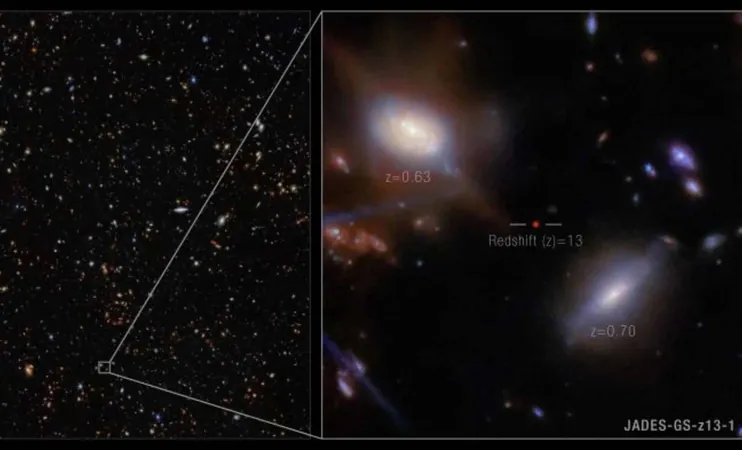
A Stunning Revelation: Webb Telescope Captures Early Galaxy Emitting Surprising Light Signal
2025-04-22
Author: Ling
A Revolutionary Discovery in Cosmic History
Astronomers are on the brink of rewriting the history of the early Universe. Thanks to the powerful James Webb Space Telescope (JWST), researchers have detected a distant galaxy named JADES-GS-z13-1, sending out a strong Lyman-α signal—an intriguing form of hydrogen light—just 330 million years post-Big Bang.
Challenging Established Notions
This finding presents a monumental challenge to our understanding of the Universe's early days. It was long believed that during this period, the Universe was enveloped in neutral hydrogen gas that would have inhibited such emissions. However, the crystal-clear signal detected suggests that the epoch of reionization—when the first stars and galaxies began to illuminate the cosmos—may have initiated earlier than previously thought or followed more complex pathways.
An Unexpected Clarity
The galaxy was first identified through remarkable deep imaging by Webb’s Near-Infrared Camera (NIRCam) as part of the JWST Advanced Deep Extragalactic Survey (JADES). Its astonishing distance was confirmed via the Near-Infrared Spectrograph (NIRSpec), revealing a redshift of z = 13.0, indicating that the light from this galaxy has traveled through space for over 13.4 billion years.
A Signal From the Past
What truly stunned scientists was the clarity of the galaxy’s spectral fingerprint. A distinct Lyman-α emission line—indicative of excited hydrogen—was unmistakably present. Such emissions are typically suppressed in the youthful Universe due to the thick veil of neutral hydrogen gas.
Roberto Maiolino, a key member of the research team, articulated the surprise: "The early Universe was bathed in a thick fog of neutral hydrogen. Most of this haze was lifted through a reionization process, completed about a billion years post-Big Bang. Yet, we're observing GS-z13-1 when the Universe was a mere 330 million years old, and it displays a remarkably clear signature of Lyman-α emission that defies our theories of early galaxy formation."
The Implications
This groundbreaking result raises crucial questions about the timeline and nature of the reionization era. The data hints that pockets of ionized hydrogen may have emerged far earlier than anticipated or that reionization happened unevenly, with certain galaxies managing to clear localized areas of fog.
The strength and clarity of the Lyman-α line indicate that photons managed to escape and traverse space without being absorbed. This could mean the galaxy created a significant ionized bubble around itself, an area where the surrounding hydrogen was stripped of its electrons by intense radiation.
A Closer Look at Cosmic Evolution
Kevin Hainline from the University of Arizona commented, "We never expected to find a galaxy like this given our current understanding of cosmic evolution. It’s as if the early Universe was covered with a thick fog, making it challenging to spot even the brightest lighthouses, yet here we are, seeing the light from this galaxy piercing through." He added, "This remarkable emission line could redefine our view on how and when the Universe underwent reionization."
The Mystery Unfolds
The source of the intense radiation observed remains a tantalizing mystery. Scientists speculate it could be linked to Population III stars, theorized to be the first generation of massive, metal-free stars, or an early active galactic nucleus (AGN) fueled by a burgeoning black hole.
A New Era in Cosmic Exploration
This discovery marks a significant milestone in cosmology. If galaxies like JADES-GS-z13-1 had the ability to ionize their surroundings at such an early stage, it suggests that the onset of the reionization era may have begun far sooner than models have indicated. Furthermore, it strengthens the hypothesis that reionization occurred in isolated bubbles, each fueled by extraordinarily luminous sources scattered throughout the primordial Universe.


 Brasil (PT)
Brasil (PT)
 Canada (EN)
Canada (EN)
 Chile (ES)
Chile (ES)
 Česko (CS)
Česko (CS)
 대한민국 (KO)
대한민국 (KO)
 España (ES)
España (ES)
 France (FR)
France (FR)
 Hong Kong (EN)
Hong Kong (EN)
 Italia (IT)
Italia (IT)
 日本 (JA)
日本 (JA)
 Magyarország (HU)
Magyarország (HU)
 Norge (NO)
Norge (NO)
 Polska (PL)
Polska (PL)
 Schweiz (DE)
Schweiz (DE)
 Singapore (EN)
Singapore (EN)
 Sverige (SV)
Sverige (SV)
 Suomi (FI)
Suomi (FI)
 Türkiye (TR)
Türkiye (TR)
 الإمارات العربية المتحدة (AR)
الإمارات العربية المتحدة (AR)